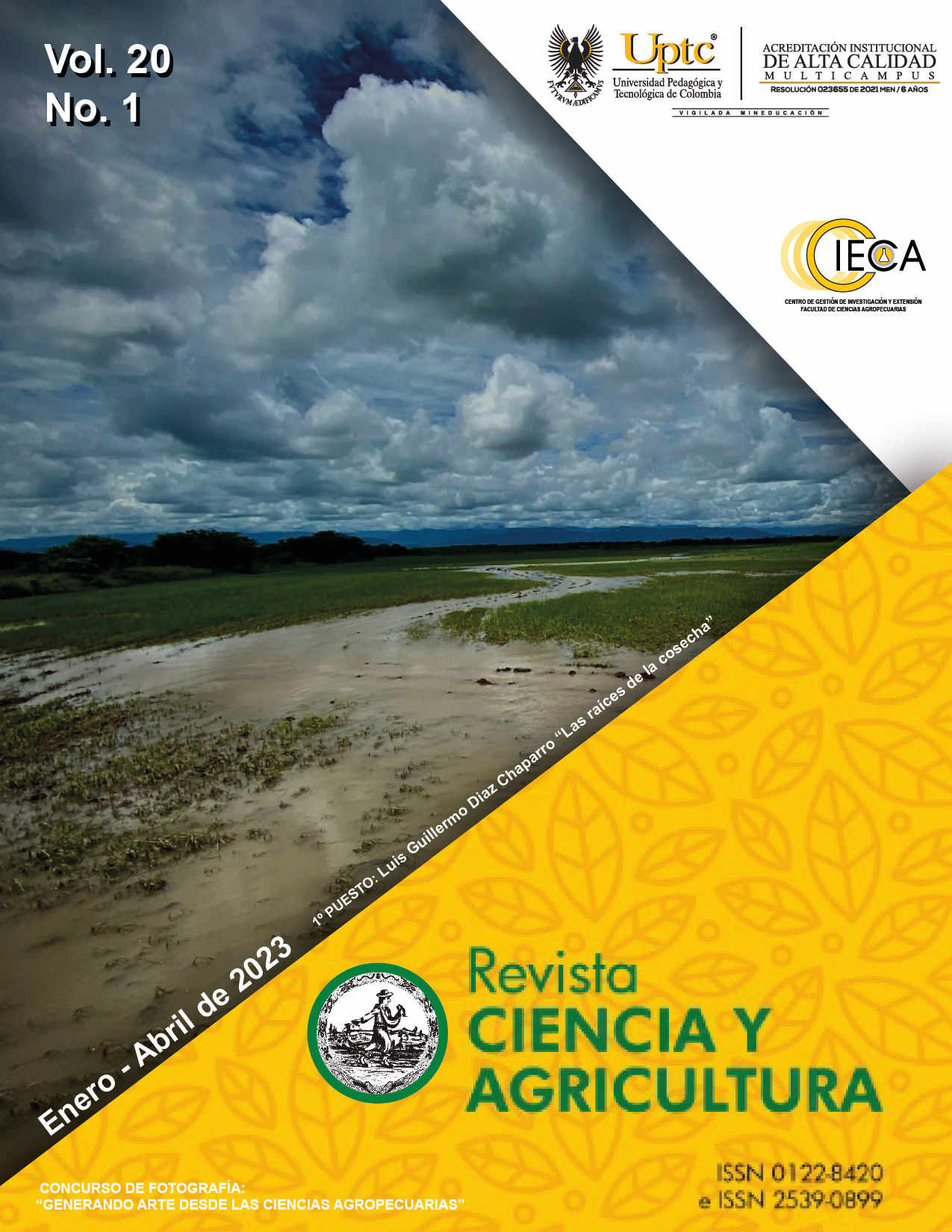Evaluation of Agronomic Traits and Severity of Foliar Disease of Three Commercial Hybrids and Five Advanced Triple Hybrids of Hard Yellow Maize

Abstract
Field experiments were conducted to evaluate agronomic traits and response to foliar fungal diseases of five advanced triple hybrids of hard yellow maize (Zea mays L.) and three commercial hybrids. An A × B factorial experiment with eight treatments, four repetitions and the Tukey test was used to compare means of the treatments (P>0.05). The most limiting disease is rust. The agronomic characteristics of breeding lines: h1, h2, h3, h4 and h5 (triple hybrids) were evaluated and compared with h6, h7, and h8 (commercial hybrids). Field trials were conducted in two locations of Central Coast of Ecuador (Quevedo & Balzar). Both locations showed significant differences for agronomic traits; Balzar presented lower yield (6,205.46 kg ha-1) and greater severity of curvularia leaf spot (3.34 CIMMYT scale) compared to Quevedo (7,368.21 kg ha-1 and 2.47 CIMMYT scale). For hybrids, h6 had significantly lower yield (5,306.83 kg ha-1), compared to h5 (6,914.09 kg ha-1), h1 (7,211.80 kg ha-1), h3 (7,266.83 kg ha-1), and h8 (8,036.85 kg ha-1). Significant differences were also detected for the orthogonal comparison (INIAP hybrids) with 5,634.44 kg ha-1 and the promissory lines with 6,997.68 kg ha-1. The highest net profit was achieved with the hybrid h2 with USD 1,405.76 followed by the hybrid h1 with USD 1,385,92, obtaining a Benefit-Cost ratio of 2.32 and 2.30 respectively, which indicates that for each monetary unit invested, an additional USD 1.32 and 1.30 of profit was obtained for the two hybrids, respectively.
Keywords
Breeding plant, Yield, Disease resistance, New cultivars, Zea mays L., Ecuador
References
- Arias, C. (2003). Evaluación del comportamiento agronómico de diez híbridos de maíz en la zona de Ventanas durante la época lluviosa (Undergraduate thesis]. Universidad Técnica Estatal de Quevedo.
- Beck, D., & Vasal, S. K. (1993). Our clients, their research capacities and germplasm needs. In R. N. Wedderburn (Ed.). International testing evaluating and distributing maize germplasm products (pp. 1-10). CIMMYT.
- Carpane, P. D. (2007). Host resistance and diversity of Spiroplasma kunkelli as components of corn stunt disease [PhD thesis]. Faculty of the Graduate College, Oklahoma State University. https://shareok.org/handle/11244/6730
- CIMMYT, International Maize and Wheat Improvement Center. (1985). Managing trials and reporting data for CIMMYT's international maize testing program. CIMMYT. In: https://repository.cimmyt.org/xmlui/bitstream/handle/10883/697/13201.pdf
- CIMMYT, International Maize and Wheat Improvement Center. (2004). Enfermedades del maíz: una guía para su identificación en el campo (4th ed). https://repository.cimmyt.org/bitstream/handle/10883/715/25905.pdf?sequence=1&isAllowed=y
- Donoso, C. (2008). Comportamiento de tres híbridos de maíz bajo diferentes poblaciones y distancias de siembra. Mocache - Los Ríos [Undergraduate thesis]. Universidad Central del Ecuador, Facultad de Ciencias Agrícolas
- Garcés, F. R., Aguirre, Á. J., Carbo, J. J., & Liubá, G. A. (2011). Severidad de curvularia en 67 lineas autofecundadas S4 de maíz amarillo. Ciencia y Tecnología, 4(2), 39-44. https://doi.org/10.18779/cyt.v4i2.107 DOI: https://doi.org/10.18779/cyt.v4i2.69
- Ibarra-Velásquez, A. A., Ramírez-Flores, L. C., Molina-Villamar, J., & Zuñiga-Moreno, L. E. (2023). Análisis de la cadena agroalimentaria del maíz en Ecuador. Polo del Conocimiento, 8(1), 1862-1873.
- INAMHI, Instituto Nacional de Meteorología e Hidrología. (2006). Anuario Meteorológico.
- IICA, Istituto Interamericano de Cooperación para la Agricultura. (2019). Guía técnica de cultivo de maíz. https://repositorio.iica.inte/handle/11324/11893
- Matsuoka, Y., Vigouroux, Y., Goodman, M. M., Sanchez G., J., Buckler, E., & Doebley, J. (2002). A single domestication for maize shown by multilocus microsatellite genotyping. Proceedings of the National Academy of Sciences of the United States of America, 99(9), 6080-6084. https://doi.org/10.1073/pnas.052125199 DOI: https://doi.org/10.1073/pnas.052125199
- OECD/FAO. (2020). OCDE-FAO perspectivas agrícolas 2020-2029. OECD Publishing. https://doi.org/10.1787/a0848ac0-es DOI: https://doi.org/10.1787/a0848ac0-es
- Troyer, A. F. (1996). Breeding widely adapted, popular maize hybrids. Euphytica, 92(1), 163-174. https://doi.org/10.1007/BF00022842 DOI: https://doi.org/10.1007/BF00022842
- Wang, B., Lin, Z., Li, X., Zhao, Y., Zhao, B., Wu, G., Ma, X., Wang, H., Xie, Y., Li, Q., Song, G., Kong, D., Zheng, Z., Wei, H., Shen, R., Wu, H., Chen, C., Meng, Z., Wang, T., et al. 2020. Genome-wide selection and genetic improvement during modern maize breeding. Nature Genetics, 52, 565-571. https://doi.org/10.1038/s41588-020-0616-3 DOI: https://doi.org/10.1038/s41588-020-0616-3
- Wang, X., Li, Y., Han, W., Song, Z., Wang, S., & Yang, J. (2022). Evaluation of root lodging resistance during whole growth stage at the plant level in maize. Scientific Reports, 12, 10375. https://doi.org/10.1038/s41598-022-14159-0 DOI: https://doi.org/10.1038/s41598-022-14159-0
- Wise, K., Kennedy, B., Mehl, K., & Bradley, C. A. (2018). Physoderma brown spot of corn (PPFS-AG-C-07). University of Kentucky. http://plantpathology.ca.uky.edu/files/ppfs-ag-c-07.pdf
- Wise, K., Anderson, N., Mehl, K., & Bradley, C. A. (2019). Curvularia leaf spot of corn (PPFS-AG-C-09). University of Kentucky. https://plantpathology.ca.uky.edu/files/ppfs-ag-c-09.pdf
- Yara Ecuador. (2023,18 june). Cómo aumentar el rendimiento del maíz. https://www.yara.com.ec./
